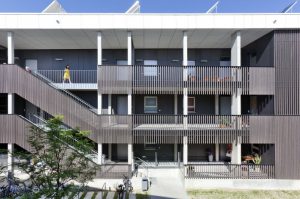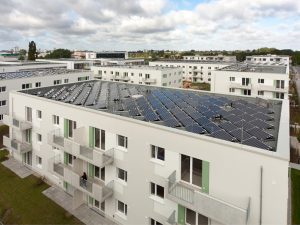1:38 min, from 2.2.2018
Project Info: http://sdg21.eu/db/studierenden-wohnheim-woodie
Keywords: DE-News, Movies, Movies < 4 Min, Wood construction, News Blog Hamburg, Student housing
1:38 min, from 2.2.2018
Project Info: http://sdg21.eu/db/studierenden-wohnheim-woodie
Online until 19.01.2026
In the video contribution, among other things, the Munich timber housing estate "Prince Eugene Park" and the City of Wood in Bad Aibling.
"Drought and bark beetles are taking their toll on the forest. The resulting damaged wood has caused the price of wood to plummet. The local forest owners are making a loss, even though the beetle wood is exported thousands of kilometres to China and America as construction timber. What could be the solution to the timber crisis? And could more timber construction in our country also be a way out of the climate crisis?"
Keywords:
Movies, Movies 11 to 45 Min, Wood construction, NaWaRohs, News Blog Bavaria
Many new projects, new photo galleries or new individual project photos have been added to the web database www.siedlungen.eu in 2018. The following is an overview.
Living at the Dantebad

Project link: http://sdg21.eu/db/wohnen-am-dantebad
Directly to the photo gallery:
https://siedlungen.eu/galerien/fotogalerie-2018-wohnen-am-dantebad
Many thanks to Johann Hartl for the photos!
There are five new photo galleries from the Lake Constance region in May. On behalf of the users of this website, I would like to thank Thomas Pommer!
Wooden student residence in Constance
Project link: http://sdg21.eu/db/studierendenwohnheim-in-holzbauweise
Lichtblick-COOP in Leutkirch im Allgäu
Project link: http://sdg21.eu/db/coop-leutkirch
Biosolar residential complex Ravensburg-Eichwiesen
 Project link: http://sdg21.eu/db/biosolare-wohnanlage-ravensburg-eichwiesen
Project link: http://sdg21.eu/db/biosolare-wohnanlage-ravensburg-eichwiesen

Wooden housing estate Ingolstadt
http://sdg21.eu/db/holzbausiedlung-ingolstadt

Wooden housing estate with 213 units in Berlin Weißensee
http://sdg21.eu/db/weissensee

Climate-neutral home for 128 tenants in Berlin-Adlershof
Project Info: http://sdg21.eu/db/plusenergiehaeuser-in-berlin-adlershof
Many thanks to Deimel Oelschläger Architekten, Berlin for the rights to use the illustration.
Active townhouse in Frankfurt
Project link:
http://sdg21.eu/db/aktiv-stadthaus-in-frankfurt
The largest PV housing estate in Germany

825 kWp in Gelsenkirchen- Schaffrath
Project link:
http://sdg21.eu/db/die-groesste-pv-wohnsiedlung-deutschlands
Addition to Nordstadt Karlsruhe
With 526 residential units, the two-storey extensions in timber frame construction are the largest contiguous timber construction project in a housing estate in Europe in the last 40 years
Photo: Bernhard Mangold-Märkel
Project link:
http://sdg21.eu/db/aufstockung-nordstadt-karlsruhe
Ellener Hof Foundation Village in Bremen: Ecologically Built - Colourfully Mixed
Project link:
http://sdg21.eu/db/stiftungsdorf-ellener-hof-oekologisch-gebaut-bunt-gemischt
The country lists with more than 10 projects can now be filtered according to further criteria. The projects can now be displayed according to other criteria in addition to the postcode sorting:
https://siedlungen.eu/projekte/baden-wuerttemberg
https://siedlungen.eu/projekte/nrw
https://siedlungen.eu/projekte/bayern
https://siedlungen.eu/projekte/schleswig-holstein
https://siedlungen.eu/projekte/berlin
https://siedlungen.eu/projekte/hamburg
Also in category "Projects in development"There are now further options for narrowing down the project list.
Data protection according to the EU DSGVO
In addition, data protection was reviewed. The website was already EU GDPR compliant in most areas. However, some plugins were uninstalled and replaced or a few functions were deactivated for which it is not obvious whether they are GDPR-compliant. Read here the extended Privacy policy.
Keywords:
sdg21 news
In Sweden, a residential building is being built that is specially designed for cyclists. Malmö is considered the most bicycle-friendly city in Sweden. 30 percent of the inhabitants here use a bicycle every day, and bike sharing is booming. Soon, however, Malmö will have even more to offer cyclists: In the middle of the city centre, the first house is currently being built that is completely adapted to the needs of cycling residents.
The OHBOY! Bicycle House by the Architect's office Hauschild + Siegel. The architects are familiar with bicycle-friendly solutions - after all, they are based in Malmö's "neighbouring city". Copenhagen, the most bicycle-friendly in Europe.
Read on WIWO the whole article from 14.9.2016.
Keywords:
Bike-/Velo-City, News Blog Europe (without DE), News Blog Sweden
Introduction
On 16 June, the member states of the European Union agreed in the Permanent Representatives Committee to a comprehensive reorganisation of the EU-Renewable Energy Directive (RED). The European target for renewable energies will thus be significantly increased from 32% to 45% in 2030. This means a doubling of the share of renewable energies compared to the level achieved in 2021 of just under 22%.
This is a great success for the expansion of renewables: The planned expansion of renewable energies by 2030 will thus be roughly doubled. For the new targets, the EU more than 100 GW of new wind turbines and solar plants are installed every year. For Germany hott that the greatly increased expansion targets for wind and solar energy in 2022 are underpinned by European requirements and become binding. The higher EU-targets also provide the framework for further measures and targets in the EUFor example, the solar strategy of the EU, which roughly triples the PV-capacity to 600 GW by 2030.
Federal Minister of Economics and Climate Protection Robert Habeck: "I am very pleased that the Council has today backed the agreement of 30 March. The revised directive will massively accelerate the expansion of renewables across the European Union. We are raising the renewables target for 2030 from 32% to 45%. In particular, wind and solar energy will be expanded twice as fast as previously envisaged. The new European rules will trigger a boom of investments in renewables and make them legally binding. For us, this means: our massively increased expansion targets for wind and solar energy last year will now be underpinned by European requirements. This will make us less dependent on energy imports. For me, it is very important that it is not only about targets, but also about measures. That is why I have worked to ensure that many of the accelerated approval procedures for renewable energy projects, which we agreed on in the 2022 energy crisis, are now made permanent. Permits are coming faster, planning is being accelerated. I am therefore pleased that the European Union has the strength to make such a success for renewable energies possible."
The agreement also enables the breakthrough of renewable energies in sectors other than electricity in the future. In the heating sector, in transport and in industry, binding targets for the use of renewable energies now apply in every single country. The switch to renewable energies in all sectors will become mandatory at the European level. In Germany alone, for example, industry will have to use hydrogen from renewable energies on a large scale in 2030, around 20-25 TWh. To ensure that the targets are also translated into action, there is a threat of infringement proceedings if a country does not meet its sectoral targets.
In addition, approval procedures will be accelerated significantly and permanently. Among other things, specific deadlines will be set for this: The approval process for new renewable energy projects in certain areas may no longer take longer than 12 months. It is also important that hydrogen from nuclear power will continue not to be credited to EU-targets takes place - the RED only counts renewable energy towards the targets.
There was also an agreement on 16 June on the market ramp-up of e-fuels in aviation in particular, the so-called "ReFuelEU Aviation". The EU introduces a quota for the market ramp-up of e-fuels ("RFNBOs") in the aviation sector, from 1.2% e-fuels in 2030 to 35% e-fuels in 2050. A total of 70% of aviation fuels must then be renewable in 2050. In aviation, e-fuels are particularly important as direct electrification is only possible to a limited extent.
The agreement now reached on an amendment to the EU-Renewables Directive (RED III) provides that the EU-2030 target for renewable energies increases to a total of 45% of total energy consumption (gross energy consumption). 42.5% are to be provided as binding by the member states as before. In this context, the already existing governance regulation ensures that this target is actually achieved. For example, concrete measures are taken if there are indications that the expansion of renewables is not yet sufficient. In addition, there is an indicative additional target of 2.5 percent. This "top-up" is to be achieved through further voluntary contributions by the member states or through pan-European measures. This doubles the EU their ambition in expanding renewable energies. According to initial projections, the German targets are sufficient to meet the new EU-targets. Now we have to do everything we can to achieve our national expansion targets.
The agreement introduces further binding national sectoral targets for the use of renewable energies. If a member state does not comply with these binding sectoral targets, it faces infringement proceedings. The share of renewable energies must grow by 0.8 percentage points each year between 2021-2025 and by 1.1 percentage points each year thereafter. In addition, there is a new indicative buildings target of 49% renewables of heat demand in buildings. In the transport sector, the already binding target increases from 14% to 29%. A new binding sub-target in transport includes a combination of electricity-based renewable fuels (RFNBOs) and advanced biofuels. This sub-target is 5.5%, of which 1% is to be covered by hydrogen and other electricity-based fuels (RFNBOs).
In the industrial sector, a new mandatory target is set for the use of hydrogen and other electricity-based fuels (RFNBO). 42% of the hydrogen consumed in industry in 2030 must come from renewable energy sources. This corresponds to an increase to about 20 to 25 TWh. By 2035, the share is expected to rise to 60%. Depending on the scenario, this will require around 41 to 83 TWh hydrogen from renewable energy sources is needed, as in parallel industry is using more and more hydrogen. In addition, a new indicative target is that the share of renewable energy in total energy consumption in industry should increase by 1.6% each year.
The regulations for accelerating the approval procedures for the expansion of renewable energies and grids, which are contained in the EU-The provisions of the Emergency Ordinance are largely laid down. For example, renewable energy and grid expansion are in the overriding public interest and time-consuming assessment steps can be dispensed with in the priority areas (no second environmental and species protection assessment at project level if there has already been an assessment at planning level). However, this only applies if appropriate avoidance or compensation measures have been taken, i.e. the level of nature conservation remains high.
In addition, there is a new impetus for cross-border RE projects: each Member State has to start at least one cross-border cooperation project; so that joint cooperation is strengthened. Such cooperation projects include, for example, joint offshore projects. With the recently signed German-Danish offshore project "Bornholm Energy Island", Germany is one of the pioneers in the EU.
On the long-disputed issue of crediting low-carbon fuels (sog. "low-carbon fuels), such as hydrogen based on nuclear power, a compromise was also found. Low carbon fuels are not counted towards the RE targets. Thus, a clear distinction will continue to be made between green H2 and low carbon H2. The German government had strongly advocated this in advance. Member states that have not met their national target contribution to the EU-2030 target, and whose industry uses almost exclusively decarbonised fuels, receive a discount on the hydrogen sub-target in industry and thus somewhat more flexibility.
The simultaneous agreement on ReFuelEU Aviation means that e-fuels will be highly encouraged in aviation, where they are urgently needed, as direct electric propulsion is hardly possible here. This now applies to EU-level what has already been law in Germany since 2021: the German e-fuels quota was so far the world's first obligation to use these fuels. EU-wide, from 2030 onwards, at least 1.2 % e-fuels will be used and by 2032 already 2 %. The ratio rises to 35% by 2050. %. Overall, in the target year 2050, at least 70 % renewable aviation fuels are used, i.e. in addition to e-fuels, also biofuels from residual and waste materials.
Source: BMWK-PM of 16.6.2023
Keywords:
DE-News, Renewable, European Green Deal, Climate protection, SDG 2030, Environmental policy